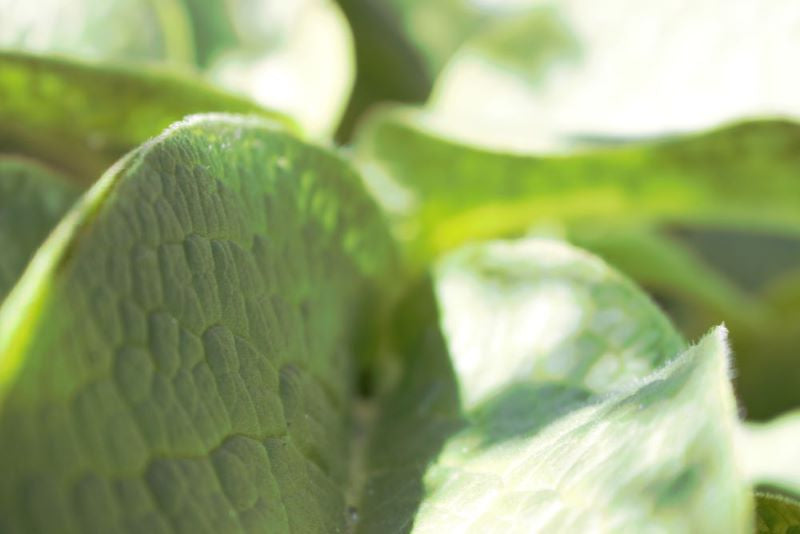
What is Comfrey and Why You Should Plant it in Your Garden!
Rebecca HaynesShare
Comfrey - Botanical name- Symphytum officinale (also known as black wort, boneset, bruise wort, comfrey, knitback, knitbone, slippery root).
Comfrey is actually a group of plants containing about 35 different species and is part of the Borage family of plants.
Comfrey is a perennial herb originally found in moist grasslands in western Asia, Europe, and North America. Comfrey can grow to a height of 1–3 ft (0.3–0.9 m). It has a black, turnip-like root and large, hairy broad leaves. It has small bell-shaped flowers of various colours, typically cream, white, pink or purplish.

Comfrey- uses in the garden
If there is one plant that every garden in Australia should contain, Comfrey is probably it. No it is not edible (although it does have it's place in herbalism), however Comfrey does have a multitude of other uses.
Comfrey for soil preparation
Comfrey has deep taproots that aid in breaking up hard, compacted soil. This makes it fantastic to plant in soil that is otherwise clumpy and hard for plants with finer root systems to grow. Once the comfrey has done its work, you can remove it and plant your other more delicate plants.
Comfrey is a living compost for your garden.
In areas where the top soil has been depleted, the taproots can reach the nutrients way down below where your average plants cannot. For this reason, Comfrey is high in many of the nutrients and micronutrients needed by most plants such as nitrogen, potassium, calcium, magnesium and iron. This way, Comfrey aids in breaking up the soil so that it is not a hard mass, it also adds all of those harvested minerals to the soil when it sheds it's leaves and they break down on top of the garden.
Comfrey acts as a great mulch
Because the comfrey plant has a prolific growth pattern and contains a lot of nutrients, the comfrey leaves make a fantastic mulch. The leaves can be chopped up and added to the top layer of soil in a garden to both retain some moisture within the soil and to add nutrients. This is also commonly referred to as "chop and drop".

Comfrey makes a great liquid fertiliser
The leaves of the Comfrey plant are particularly high in nitrogen and make a great liquid fertiliser especially for tomatoes. You can take advantage of this by making your own fertiliser for your vegetables, saving you money and making your plants happy! In order to make this, all you need is a waterproof container, a brick, a pouring and storing container such as a milk bottle, and of course comfrey leaves.
- Place comfrey leaves in a watertight bucket (place as many as you can - or as many as you have in there!) Place a rock or heavy brick on top of the leaves to weigh them down. put lid on and wait about 6 weeks for the leaves to break down. It will produce a thick black liquid- and it will smell!!
- To use the precious fertiliser that you have made, dilute the comfrey juice 1 part juice to 15 parts water (dilute a bit more for seedlings and young plants).

Comfrey can be dried and used in the garden
Comfrey leaves and stem are also great when dried and mixed into the soil prior to planting. The leaves can be dried in a dehydrator, or can be bundled and air dried. You can then blitz the leaves and stems into a powder in a food processor- or an even easier way is to use a coffee grinder. Sprinkle a small amount onto the garden as it is very concentrated. The dried powder can also be used to make comfrey salves that are good for grazes, minor cuts and bruises etc. If turned into a salve, however, comfrey should not be used on deep wounds as it can encourage fast healing of the outer layer of skin, whilst there could still be infection underneath.
What to watch out for with Comfrey
- It does have a tendency to take over a garden. Therefore it is best if planted in a raised bed. If you are using comfrey for its soil enhancing benefits, there is really no way around planting it with your other plants. There are websites where I have seen people suggest that it be planted in pots, however this negates the main reason for using comfrey- the plant in a pot will only draw on the minerals you have to keep adding to it, therefore your mulch will only be as good as the extras you add to the soil in the pot.
- Controversial, but it should not be consumed by humans. I will let the herbalists sort this one out so as not to get sued!
